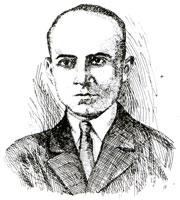Konstantin Chelpan
Konstantin Fyodorovich Chelpan | |
|---|---|
 | |
| Born | 27 May 1899 Cherdakly, Yekaterinoslav Governorate, Russian Empire |
| Died | 10 March 1938 (aged 38) |
| Resting place | Unknown |
| Nationality | Soviet |
| Education | Kharkiv Technological Institute |
| Occupation | Engineer |
| Children | Lenimir Konstantinovich Chelpan |
| Parent(s) | Fyodor Myhailovich Chelpan, Elizaveta Khalangot |
| Engineering career | |
| Discipline | Diesel engines |
| Institutions | Kharkiv Locomotive Factory |
| Significant design | V-2 engine |
| Awards | Order of Lenin |
Konstantin Fyodorovich Chelpan (Russian: Константин Фёдорович Челпан) (27 May 1899 – 10 March 1938) was a prominent Soviet engineer of Greek background. Head of the Engineering Design Bureau of the Kharkiv Locomotive Factory, chief designer of the T-34 tank engine. Awarded the Order of Lenin, he was politically repressed and executed under a mass persecution ordered by Joseph Stalin, but politically rehabilitated after death.
Early life and education
Born on 27 May 1899 in Cherdakly, Yekaterinoslav Governorate, Russian Empire (now Kremenivka, Donetsk Oblast, Ukraine),[1] to Fyodor Myhailovich Chelpan and Elizaveta Khalangot.[2] Both parents were Greeks.[1]
After graduating from Mariupol Realschule in 1919, took part in the Russian Civil War.[2] In 1924 graduated with honors from Kharkiv Technological Institute with a Major in Internal Combustion Engines.[2][3]
Career
From 1924 to 1937 Chelpan worked at the Kharkiv Locomotive Factory[3] as a Designer, Head of the Diesel Department, Lead Designer, and Head of the Engineering Design Bureau.[4][5] In 1928–1929 he received practical training in Germany, Switzerland, and the UK.[2]
Konstantin Chelpan was the head designer of the famous T-34 tank diesel engine V-2,[6] for which he was awarded the Order of Lenin.[7] The engine consisted of lightweight aluminum alloy.[8][9][10][11]
From 1927 he was a senior lecturer at Kharkiv Technological Institute.[12]
Arrest and death

Konstantin Chelpan was arrested on 15 December 1937 during the first days of the Greek Operation of NKVD.[1][2][11] He was charged with leading a Greek nationalist counter-revolutionary organization, as well as conspiring to sabotage the Kharkiv Locomotive Factory.[1][11] After being interrogated and tortured he confessed to being a spy.[2] On 4 February 1938 he was sentenced to execution by shooting.[2][3][11] The sentence was carried out in Kharkiv prison on 10 March 1938[2] and covered up.[1] In a few years his wife received a death certificate, indicating that Konstantin Chelpan died on 16 May 1942 from congestive heart failure.[1]
On 6 August 1956 Konstantin Chelpan was rehabilitated by the Military Collegium of the Supreme Court of the USSR.[2][3] However only in 1988 was his true cause of death revealed.[1][11]
Commemoration
- In 1994 one of the streets in the village of Cherdakly was named after Konstantin Chelpan.[2]
- In 2000 a book entitled Life story of famous Ukrainian Greeks. The case of Konstantin Chelpan by G. Zakharova was published.[2]
- In 2001 a commemorative plaque was placed on the house, where Konstantin Chelpan had spent his last years.[2]
References
- ^ a b c d e f g Лавриненко, Евгений (January 2011). "Челпан Константин Федорович". аллея звезд (in Russian). Archived from the original on 9 August 2013. Retrieved 19 February 2012.
- ^ a b c d e f g h i j k l Захарова, Г.М. (2001). Жизнеописания знаменитых греков Украины. Дело Константина Челпана (in Russian). Мариуполь : ЗАО «Газета "Приазовский рабочий. pp. 54–85.
- ^ a b c d Джуха, И.Г. "Челпан К.Ф." ГРЕЧЕСКИЙ МАРТИРОЛОГ (in Russian). Archived from the original on 8 December 2015. Retrieved 19 February 2012.
- ^ Ибрагимов, Даниял (1989). Противоборство: Документальная повесть (in Russian). ДОСААФ СССР. p. 59. ISBN 5-7030-0200-1. Retrieved 19 February 2012.
- ^ Джуха, Иван; Ассоциация греческих общественных объединений России (2006). Греческая операция: история репрессий против греков в СССР (in Russian). Алетейя. p. 50. ISBN 5-89329-854-3. Retrieved 19 February 2012.
- ^ Костюченко, Станислав (2004). Как создавалась танковая мощь Советского Союза, Книга 1 (in Russian). АСТ. ISBN 5-17-024396-0. Retrieved 19 February 2012.
- ^ БУГАЙ, НИКОЛАЙ; КОЦОНИС, АНАТОЛИЙ (1999). Обязать НКВД СССР ... выселить греков (in Russian). ИНСАН. pp. 159, 164. ISBN 9785858402886. Retrieved 19 February 2012.
- ^ Suzuki, Takashi (1997). The romance of engines. SAE. p. 206. ISBN 1-56091-911-6. Retrieved 19 February 2012.
- ^ Комитет по делам архивов. Министерство печати и информации (2001). Отечественные архивы, Выпуск 1 (in Russian). Отечественные архивы. p. 63. Retrieved 19 February 2012.
- ^ Ziemke, Earl (2002). Stalingrad to Berlin: The German Defeat in the East (Paper). Government Printing Office. p. 27. ISBN 0-16-001962-1. Retrieved 19 February 2012.
- ^ a b c d e "Сталинский "греческий заговор"". ГРЕКИ В РОССИИ (in Russian). ГРЕЧЕСКАЯ ГАЗЕТА. Retrieved 19 February 2012.
- ^ Павлова, Г. В. "Челпан Константин Федорович". История Харьковского технологического института в лицах 1885-1930 (in Russian). Archived from the original on 11 July 2012. Retrieved 19 February 2012.
- 1899 births
- 1938 deaths
- People from Donetsk Oblast
- Recipients of the Order of Lenin
- Soviet engineers
- 20th-century Russian engineers
- Soviet inventors
- 20th-century Russian scientists
- Great Purge victims from Ukraine
- Greek people executed by the Soviet Union
- Ukrainian people of Greek descent
- Kharkiv Polytechnic Institute alumni
- Soviet people of Greek descent
- Soviet rehabilitations
- People of the Russian Civil War
